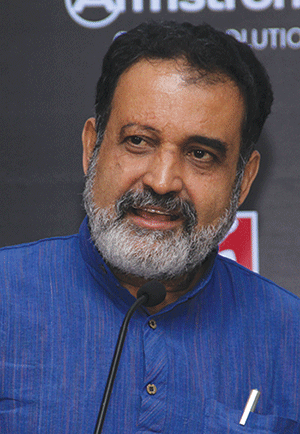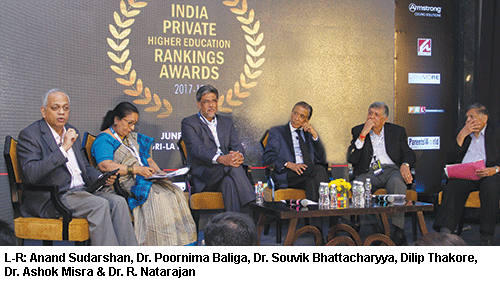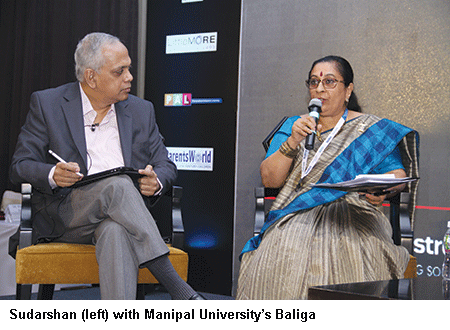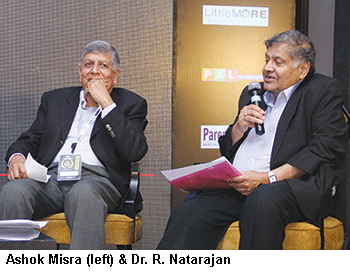A sequel to the first-ever EducationWorld India Private Higher Education Rankings 2017-18 league tables published in May, the four-hour awards nite programme celebrated the country’s most admired private universities, engineering institutes and B-schools whose growth, development and potential tend to be obscured by mainstream media - Summiya Yasmeen
The ina ugural EducationWorld India Private Higher Education Rankings Awards Nite staged at Bengaluru’s Shangrila Hotel on June 10, attracted over 150 vice chancellors, deans, trustees, and faculty of India’s top-ranked private universities, engineering institutes and business schools. The awards nite was a sequel to the first-ever EducationWorld India Private Higher Education Rankings 2017-18 league tables published in May. During the four-hour awards nite programme, the country’s most admired private universities, engineering institutes and B-schools — emerging islands of academic excellence whose growth, development and potential tend to be obscured in institutional league tables of mainstream media — were feted and celebrated
ugural EducationWorld India Private Higher Education Rankings Awards Nite staged at Bengaluru’s Shangrila Hotel on June 10, attracted over 150 vice chancellors, deans, trustees, and faculty of India’s top-ranked private universities, engineering institutes and business schools. The awards nite was a sequel to the first-ever EducationWorld India Private Higher Education Rankings 2017-18 league tables published in May. During the four-hour awards nite programme, the country’s most admired private universities, engineering institutes and B-schools — emerging islands of academic excellence whose growth, development and potential tend to be obscured in institutional league tables of mainstream media — were feted and celebrated
Among the vice chancellors, deans and promoter trustees who received awards on the occasion were Dr. Souvik Bhattacharyya, vice chancellor of BITS-Pilani; Dr. Poornima Baliga, pro vice chancellor, Manipal University; Tejal Amin, chairperson of Navrachana University, Vadodara; Ali Imran, vice president, Ashoka University, Sonipat; Nisar Ahmed, promoter-chairman of Presidency University, Bengaluru; Abhishek Gupta, CEO, Jagran Lakecity University, Bhopal; Dr. K.N. Subramanya, principal, R.V. College of Engineering, Bengaluru; P.R. Agarwala and P.K. Agarwal of the Heritage Institute of Technology, Kolkata, and Vivekanand Education Society’s Institute of Technology, Mumbai’s Prof. A. Nagananda.
In the full-card programme, the awards presentation ceremony was preceded by a keynote address ‘Education 3.0’ delivered by T.V. Mohandas Pai, chairman of Manipal Global Education Services, Bengaluru, former chief financial officer of Infosys Ltd, and well-known champion of education reform, followed by a 90-minute panel discussion on ‘How to Ensure 10 Indian Universities in Top 200 World University Rankings by 2025’ chaired by Anand Sudarshan, former CEO of the Manipal Education Group and currently chairman of the Bengaluru-based Sylvant Advisors Pvt. Ltd. Knowledgeable panelists included Dr. R. Natarajan, former chairman of the All India Council for Technical Education (AICTE); Dr. Ashok Misra, former director of IIT-Bombay and chairman of the Standing Committee of the IIT Council; Dr. Souvik Bhattacharyya, vice chancellor of BITS-Pilani; Dr. Poornima Baliga, pro vice chancellor of Manipal University, and Dilip Thakore, publisher/editor of EducationWorld.
The inaugural EducationWorld India Private Higher Education Rankings Awards which acknowledged the achievements of India’s best private universities, engineering institutes and B-schools striving for academic excellence in a discouraging environment — and which will henceforth be an annual event — concluded with accomplished amateur musicians Suleiman Jamal, Jagan Chandy and Dilip Thakore entertaining the invitees with retro music renditions.
The awards nite was supported by Armstrong World Industries (India) Pvt. Ltd; Sylvant Advisors Pvt. Ltd; Littlemore Innovations Labs Pvt. Ltd; PALGenie Technologies Pvt. Ltd and Afairs Exhibitions & Media Pvt. Ltd.
In the pages following, we present excerpts from the keynote address and panel discussion, followed by an awards nite pictorial essay.
KEYNOTE ADDRESS: T. V. Mohandas Pai
 Get going with Education 3.0
Get going with Education 3.0
Throughout history, the wealth of nations has been measured by the quality of their education institutions and knowledge generated by their intellectuals who ideated great societies and civilizations. Nalanda — the world’s first university — attracted students from many countries who came in search of knowledge. Before Nalanda, there was Takshashila University founded by Buddhist monks who were the first to debate and question dogma and established traditions. These were great citadels of knowledge established in ancient India, but destroyed by foreign invaders.
In the modern era, the strength of the United States — the most powerful and richest country of the world — is not the size of its nuclear arsenal, but its universities, higher education and research institutions which generate new knowledge every day.
It is now well established that knowledge creation drives the economic growth of nations. Contemporary India is a $2.25 trillion economy, which has grown at a CAGR of 8.4 percent from 1991 to 2016. In terms of purchasing power parity, India is an $8.7 trillion economy — the third largest in the world after China ($18.5 trillion) and the US ($17.8 trillion).
There are an estimated 265 million children enrolled in the country’s 1.4 million schools, and 35 million in the country’s 51,000 colleges and 800 universities. The point is that India is a very large country whose education system cannot — and should not — be compared with small countries such as Finland and Singapore.
Globally, education has evolved and progressed over thousands of years. Education 1.0 started with the gurukuls of India and Greek academies. These learning institutions were defined by low teacher-pupil ratios, flexible schedules and syllabuses that were highly personalised to suit every student’s requirement. But they were unscalable because access to education was restricted to the rich and/or influential elite. Formal education remained the preserve of elites for centuries, and economic output was essentially driven by human and animal labour.
Until 1850, China and India were the largest economies of the world, producing 45 percent of global GDP mainly because of their large populations and economies built on human and animal muscle power. But the Industrial Revolution which started in the mid-18th century replaced human and animal labour with machines and reshaped the meaning of scale in human society.
With the invention of the steam engine, automobile, airplane, radio, television and satellites, value chains widened and deepened to invert labour requirements. Suddenly, there was real and pressing need for many more educated and trained people in workforces to manage machines and improve productivity.
This transition from agriculture to industry and factories changed education in a very significant way, and led to Education 2.0. An outcome of the industrial age, Education 2.0 was based on the assembly line and broadcast model. Its main features were large classrooms, mass enrolment, high teacher-pupil ratios, focus on rote learning, term-based testing, and one pedagogy to teach all.
But this assembly line mass education model had its drawbacks. It prioritised literacy and recall over problem-solving and curiosity-driven education. It forced capacity expansion at the cost of personalisation and dedicated attention, and knowledge dissemination was limited to books and syllabi. Education 2.0 was focused on mass enrollment. It served its purpose, but at the cost of education quality.
Now we are in a new era driven by the growth of the Internet. Humanity’s accumulated knowledge is now freely available on the Internet, indexed and queryable. Rich multi-format content and flipped classrooms from the best faculty on any subject is available free of charge, as is on-demand tutoring, personalised and generative course structures and sequencing to meet individual needs.
T his 24/7 knowledge ecosystem and new form of learning is Education 3.0. In the new knowledge era driven by technology where content is readily and freely available, education has become asynchronised, problem-solving centric and individualised. Even as the education regulatory structure remains of the industrial age, the process of learning has changed dramatically — you can learn anywhere, anytime and anything in an environment of your choosing. This new ecosystem requires massive investment in building open public infrastructure to create free and accessible national knowledge repositories which can be scaled and optimised for quality.
Moreover, faculty and students need to innovate new tech-enabled pedagogies by collaborating with best-in-class technology companies to devise solutions such as personalised and adaptive learning, blended education, data-driven continuous assessments, multi-format simulations and practice environments.
In sum, we need to prepare our youth for Industry 4.0 where automation, artificial intelligence, robotics and technology will render millions of job profiles redundant. Industry 4.0 needs people who can ideate and innovate. That’s where Education 3.0 comes in: we must optimise teaching-learning and research to help students become problem solvers rather than information assimilators. Education 3.0 must become the force multiplier to build an innovative and future-ready India.
(T.V. Mohandas Pai is a venture capitalist, seer and chairman of Manipal Global Education Services, Bangalore)
PANEL DISCUSSION
How to Ensure 10 Indian Universities in Top 200 World University Rankings by 2025
 India hosts 800 universities with some of them — Madras, Bombay and Calcutta — founded more than 150 years ago. Yet not one of them features in the Top 200 World University Rankings league tables published by London-based Times Higher Education and Quacquarelli Symonds (QS). On the other hand, several Chinese, Korean and other south-east Asian universities are ranked in the Top 100 league tables of both these agencies.
India hosts 800 universities with some of them — Madras, Bombay and Calcutta — founded more than 150 years ago. Yet not one of them features in the Top 200 World University Rankings league tables published by London-based Times Higher Education and Quacquarelli Symonds (QS). On the other hand, several Chinese, Korean and other south-east Asian universities are ranked in the Top 100 league tables of both these agencies.
Consequently, a high-powered panel chaired by Anand Sudarshan (AS), promoter-director of the Bangalore-based Sylvant Advisors Pvt. Ltd, and comprising Dr. R. Natarajan (RN), former chairman of the All India Council for Technical Education (AICTE); Dr. Ashok Misra (AM), former director of IIT-Bombay and chairman of the Standing Committee of the IIT Council; Dr. Souvik Bhattacharyya (SB), vice chancellor of BITS-Pilani; Dr. Poornima Baliga (PG), pro vice chancellor of Manipal University; and Dilip Thakore (DT), publisher/editor of EducationWorld, discussed ‘How to Ensure 10 Indian Universities in Top 200 World University Rankings by 2025’.
Excerpts from the 90-minute parleys:
AS: Over the course of the next 90 minutes, we will discuss what are the strengths of Indian universities and major shortcomings that are preventing them from becoming the best in the world. While we will focus on building academic and research excellence, we will also keenly discuss execution, governance and externalisation. I believe Indian universities have a long way to go when it comes to building networks with higher ed institutions in India and internationally, industry and alumni.
Dr. Natarajan, the standard reaction of education institutions in India to the QS and THE World University Rankings (WUR) is that they compare apples with oranges and their rankings are not relevant to the Indian context. I want you to set the stage by explaining why Indian universities should aspire to be in the global Top 200 league tables of QS and THE?
RN: India’s large population has become an excuse for many things we haven’t achieved, including not being ranked in the WUR Top 200. Every year when the WUR are published, newspaper editorials, academia and the public become very concerned that not a single Indian education institution is in the Top 100 or 200. That’s natural. In cricket we want our team to be the best in the world, likewise in academics.
No doubt it hurts us that although we have a great education tradition dating back thousands of years, none of our universities are ranked in the Top 200. Now it’s high time we stop feeling hurt and do something about it. For too long, we have been giving all types of excuses — that we are different, our universities give importance to social inclusion, affordability and equity in education, etc. The introduction of NIRF rankings by the Central government in which Indian universities are ranked inter se won’t help us move up in global rankings. NIRF is an exercise in futility. Indian universities need to benchmark themselves globally. As a country with the largest population of young people in the world, we owe it to them to provide globally comparable education.
AS: Dr. Misra is this feasible at all? Ten Indian universities in the Top QS/THE 200 WUR in the next eight years.
AM: First of all, I believe Indian universities should do right by their students and the country. Then the rankings will follow. If we chase rankings too hard, our universities won’t do what they are supposed to do for the country. Also, the QS/THE WUR don’t set a level playing field for all universities — the assessment parameters have been set by foreign rating agencies with their own understanding of academic excellence.
Nevertheless, I believe the target of 10 Indian universities in Top 200 by 2025 is achievable. Every year, about 1 million students enter India’s higher education system. If we aren’t able to ignite even 10 percent of these bright young people, there’s something seriously wrong with our education system. A university is built on three major pillars — teaching, research and innovation. Those higher ed institutions able to create new knowledge for the benefit of the economy and country have the best chance of entering the Top 200. For research and innovation, we require excellent and dedicated faculty. There already is a small nucleus of talented students and faculty in our best universities. We need to grow that number. And most important, there needs to be strong will in every Indian public and private university to make pursuit of excellence the top priority.
AS: Dr. Bhattacharyya, what’s your take? How can we ensure that at least 10 Indian universities feature in the WUR Top 200?
SB: I want to highlight some facts. Even though in the overall rankings of Times Higher Education no Indian university is among the Top 200, in THE’s subject-wise rankings four-five Indian institutions are ranked among the Top 100. These include IIT-Kharagpur, IIT-Bombay and IIT-Madras. And for the first time this year in the QS World University Rankings, two private institutions — Manipal University and BITS-Pilani — have debuted in the Top 800.
Turning to your question as to how to ensure that 10 Indian universities enter the QS/THE Top 200, I’d like to point out the major weaknesses of Indian universities which need to be fixed for this to become possible. Over the years, the quality of our postgraduate programmes has declined. The world’s Top 200 universities offer excellent research-intensive postgrad programmes with an international mix of students. If Indian universities want to be in the reckoning, they need to dramatically improve the quality of their postgrad programmes. Also, over-dependence of Indian universities on government grants is a major vulnerability. On the internationalisation parameter too, our universities fare poorly and translational research is severely neglected. There is also no strategic planning on achieving long-term targets in most Indian universities.
AS: A large percentage of thinking and doing in multi-disciplinary universities in India is focused on achieving excellence in engineering and sciences. Dr. Baliga, from your perspective of health sciences and medical education, what are the things Indian universities need to do to be ranked among the best in the world?
 PB: This is a very relevant topic and I strongly believe it’s not difficult for at least 10 Indian universities to be ranked in the Top 200 WUR by 2025. We need to dare to dream. Ranking higher education institutions is necessary to prompt introspection on ways and means to become comparable with the best in the world. For premier Indian universities to break into the Top 200 WUR, they need to focus on hiring top-class faculty, engage in bench to bedside translational research, work towards internationalisation and draw up strategic development plans.
PB: This is a very relevant topic and I strongly believe it’s not difficult for at least 10 Indian universities to be ranked in the Top 200 WUR by 2025. We need to dare to dream. Ranking higher education institutions is necessary to prompt introspection on ways and means to become comparable with the best in the world. For premier Indian universities to break into the Top 200 WUR, they need to focus on hiring top-class faculty, engage in bench to bedside translational research, work towards internationalisation and draw up strategic development plans.
To share Manipal University’s experience, we first set ourselves the goal of improving teaching and research to be ranked in league tables such as THE’s BRICS and Asia Rankings and succeeded in breaking into the Top 400. By persisting with recruiting excellent faculty, internationalisation, inter-disciplinary research, incubation, strategic planning and execution, we have improved learning and research outcomes to be ranked in the 701-800 category of the QS WUR 2017-18.
AS: Dilip, in your opinion what are the three major roadblocks preventing Indian universities from being the best in the world?
DT: First, I want to emphasise that high rank in the QS/THE WUR is a goal worth pursuing. It’s time India began competing with the big boys without making excuses. But I don’t think our universities can achieve this goal unless they fulfill some pre-conditions.
 The most important pre-condition is that the faculty and administration of India’s top-ranked universities need to stand up to government. The neta-babu brotherhood knows little about education, yet it is constantly interfering in the administration of universities. Persistent government interference is the main reason why our public universities, some of which were promoted 150 years ago, don’t fare well in global rankings. In China for instance, the government has identified 10 universities with potential. It has granted them full autonomy, funds and resources to ensure they make it to the Top 100. We need to do likewise in India.
The most important pre-condition is that the faculty and administration of India’s top-ranked universities need to stand up to government. The neta-babu brotherhood knows little about education, yet it is constantly interfering in the administration of universities. Persistent government interference is the main reason why our public universities, some of which were promoted 150 years ago, don’t fare well in global rankings. In China for instance, the government has identified 10 universities with potential. It has granted them full autonomy, funds and resources to ensure they make it to the Top 100. We need to do likewise in India.
AS: To round off this engaging discussion, I’d like to ask each panelist to suggest three initiatives in terms of governance and vision execution which Indian universities need to undertake to enter the QS/THE Top 200 WUR by 2025.
SB: My recommendation is that first, every Indian higher ed institution should clearly define its USP (unique selling proposition). Next, it should articulate its goals, draw a roadmap to achieve them and devise objective metrics to assess performance. The management, faculty and students should take ownership of the vision document and ensure its smooth execution. I also strongly recommend universities to use institutional knowledge analysis to enable managements to practice evidence-based decision-making.
AM: To break into the global rankings, Indian universities need to focus on governance, academic leadership and research excellence.
Governance has to be top-class and guided by a vision document setting institutional goals to benefit students and faculty. Secondly, academic leadership which is at its lowest point, needs to be reasserted — I prefer not to go into the murky details of how vice chancellors of public universities are appointed. But if we aspire to get at least 10 Indian universities in the Top 200 WUR, a plan to nurture and train academic leaders who can implement robust governance systems is a prerequisite.
Finally, we need to build a strong research and innovation culture in our universities. This will not only improve teaching-learning but will also attract high-quality faculty.
RN: In the 1990s, AICTE launched the Technical Education Quality Improvement Programme (TEQIP) to improve the quality of engineering education in the country. In the first and second phases, we focused on improving curriculum, pedagogy and the quality of output. Now the project is in its third phase. Based on the TEQIP experience, a group of educationists led by me have authored a handbook for good governance. In this handbook we have stressed the need for every institution to prepare a strategic plan and ensure its execution — we are good at making plans but bad at implementing them.
Moreover, I strongly believe our universities need autonomy and freedom to experiment and innovate. We need regulations that are enabling, benign and good for the advancement of the frontiers of knowledge.
PB: I want to reiterate the points highlighted by my co-panelists: vision document, SWOT analyses and research excellence. Focus on these three areas is imperative for Indian universities to attain the teaching and research excellence which is the hallmark of the world’s Top 200 universities.
AS: To conclude, there’s unanimity among the panelists that it is possible for at least 10 Indian universities to make it into the QS/THE Top 200 WUR by 2025. But to achieve that target, they have to write clear vision documents, and draw up strategic plans to implement vision documents.
Moreover, they need to develop strong academic leadership, and focus on research excellence. But the stimulus for change in India’s higher education institutions has to come from within the system rather than be pushed from outside.